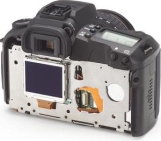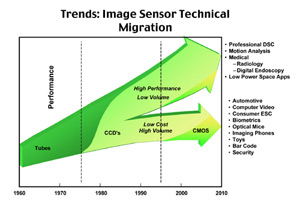Charge-Coupled Devices (CCDs) have been
the dominant image sensors, but complementary metal oxide semiconductor
(CMOS) sensors are catching up fast, creating a big market opportunity.
CMOS received its name not by the specific type of sensor technology,
but by how the sensor is manufactured. The manufacturing process is
simple compared to the older technology. CMOS incorporates a
camera-on-chip technology, which allows customized multiple circuitry to
be added to the single chip without any supporting chips. There are two
types of CMOS sensors - passive and active. In the coming years, CMOS
sensors are expected to increasingly displace the CCDs that, until now,
have dominated the market for sensors used in products such as video
recorders, digital still cameras, handheld devices, and audio
equipment's.
Currently, CCDs have a large percent share of the imager market,
reflecting their past ability to outperform devices manufactured using
other technologies. However, CCD systems are more expensive, consume
large quantities of power, are inflexible in operation, and need an
array of supporting circuitry to function. In contrast, modern CMOS
image sensors have all the necessary electronics on the chip,
drastically reducing their size and power requirements and enabling them
to go significantly beyond the pricing, size, and power limitations of
CCDs. CMOS has the lowest power consumption of all the technologies in
existence today. As technology advances, the demand for lower power
consumption should increase. CMOS sensors can extend the battery life of
digital cameras, so that consumers can use them for longer periods of
time without recharging.
Potential Markets
According to Frost & Sullivan, the CMOS image sensor market will see
a compound annual growth rate of 33 percent and revenues are expected to
touch $4.64 billion by 2007, compared to 6.2 percent of the rival
technology, the CCDs.
 |
Leading Players
 |
Agilent Technologies,
Inc., is a corporation formed by the restructuring of Hewlett-Packard
Company. In October 1998, Agilent launched its CMOS sensors with a
digital imaging platform that would be modeled by many companies
entering the market. A little over a year later, Agilent celebrated the
shipment of its one millionth CMOS sensor. Agilent's market share proves
that the company is leading the CMOS sensor market in developing the
standards in fabrication. Many small independent companies are trying to
mirror Agilent's quality and cost-effectiveness.
In June 1998, Hyundai Electronics of Seoul, Korea announced its
development of CMOS sensors. Hyundai's CMOS sensor family uses 8-bit ADC
in features such as direct digital output, pan control, frame-rate
control, readout mode control, and automatic gain control.
ST Microelectronics is the world's third largest independent
semiconductor company. The company designs, develops, manufactures, and
markets a broad range of semiconductor integrated circuits (ICs) and
discrete devices used in a wide variety of microelectronic applications,
including telecommunications systems, computer systems, consumer
products, automotive products, and industrial automation and control
systems. In June 2001, ST Microelectronics announced the availability of
fully functional samples of a new CMOS read/write channel chip for hard
disk drives. It allows drive manufacturers to cut manufacturing costs,
reduces power consumption, and increases overall data transfer speeds.
The Future
The image sensor market is a growing industry with a strong foundation
provided by a sturdy CCD technology. The battle for market share in the
image sensor industry will be between CMOS and CCD. New applications
found in the automotive and hand held communication industries are
expected to be promising with the launch of CMOS. Some changes in the
growth rate are anticipated to occur with this launch. As demand for
these products increase, CMOS will end the market control that CCDs have
enjoyed... Advantage CMOS.
Cahners In-Stat Group, a Scottsdale, AZ-based market research firm, estimates that CMOS sensors accounted for just 7.2% of all image sensors shipped in 1999 and 6.2%, or about $62 million, of the industry’s $1 billion in worldwide sales. Yet by 2004, it forecasts, CMOS sensors will account for 50.8% of the units shipped, and 35.5% of revenues. Another market-research firm, San Jose, CA-based Frost & Sullivan, forecasts nearly 60% compound annual growth for the worldwide CMOS sensor chip market from 1998 through 2003, compared with 6.2% for CCDs. It expects market revenue for all types of image sensors to reach $1.7 billion in 2003.
As the figure shows the current sensor market divides itself into two areas: the high-performance, low-volume branch, and the low-cost, high-volume branch. In the high-performance branch are applications that will continue to be dominated by CCD technology, but CMOS technology will find market share too, especially for lower cost or more portable versions of these products. The second area is where most of the CMOS activity will be. Here, in many applications CCD sensors will be replaced with CMOS sensors. These could include some security applications, biometrics and most consumer digital cameras.
Most of the growth, though, will likely come from products that can employ imaging technology—automotive, computer video, optical mice, imaging phones, toys, bar code readers and a host of hybrid products that can now include imaging. These kinds of products will require millions of CMOS sensors.
